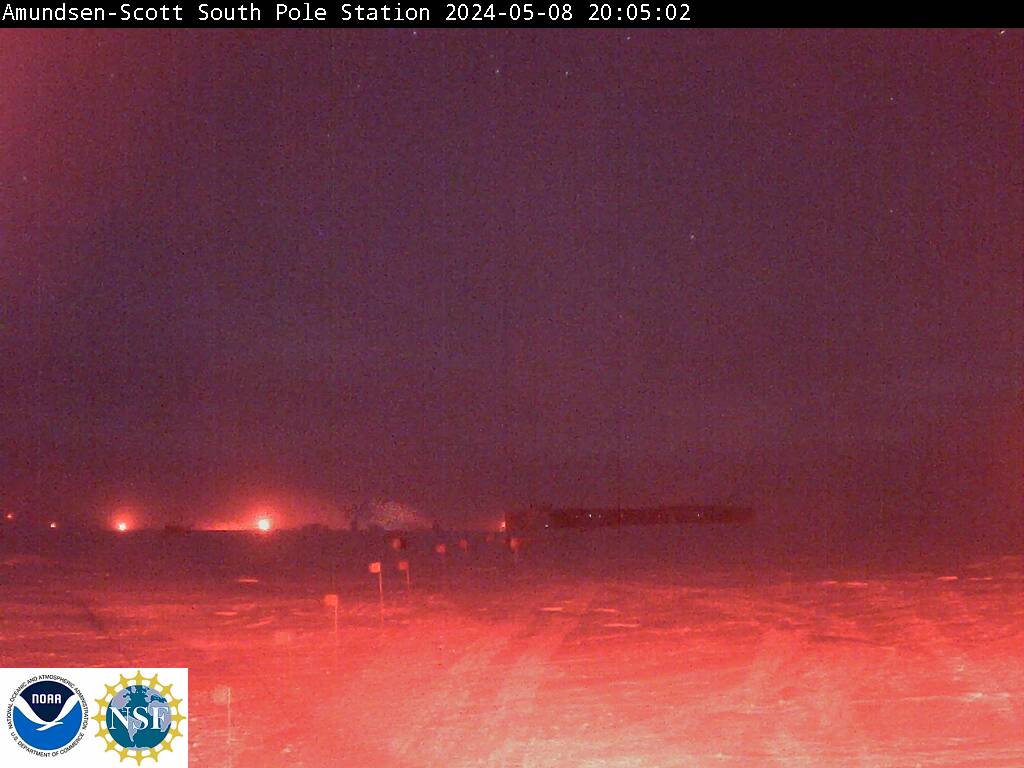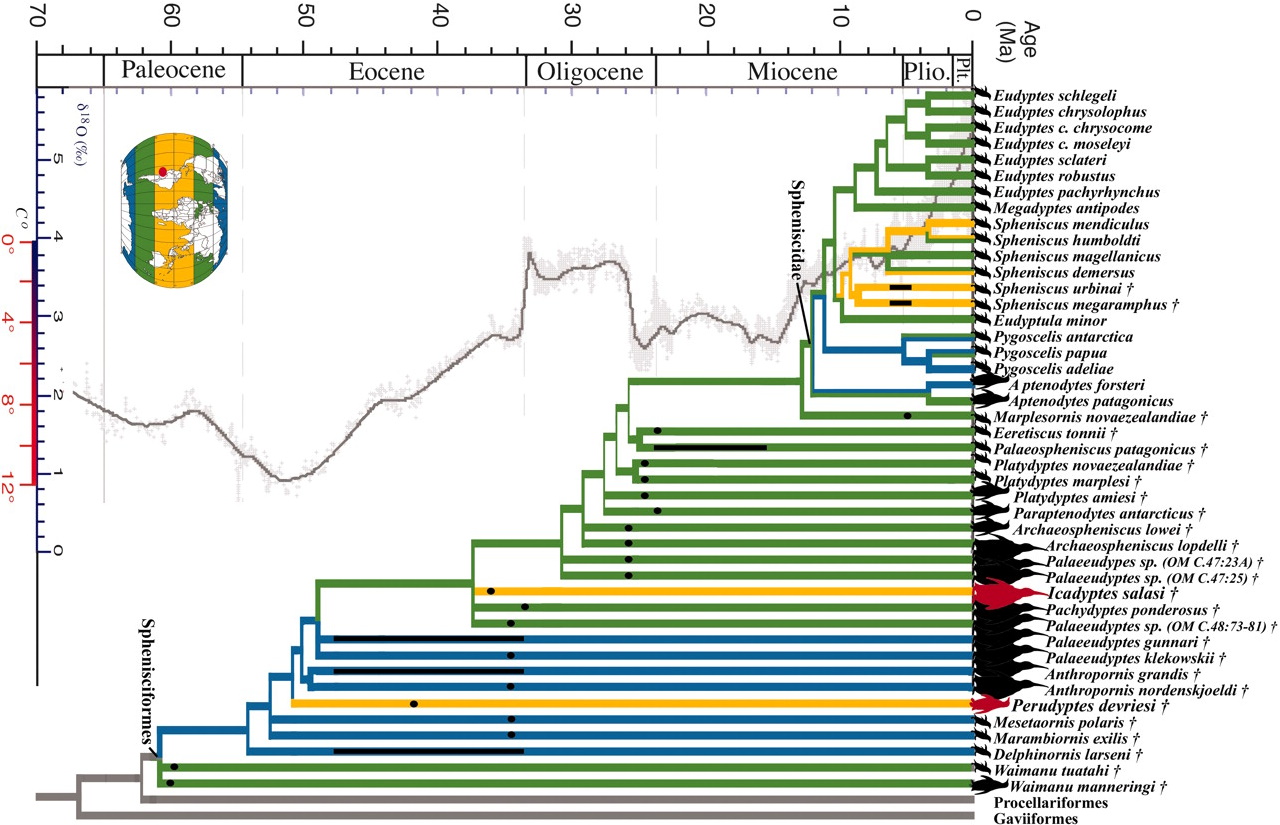* Penguins (Spheniscidae)
o distribution centered in the southernmost part of the southern hemisphere
o almost certainly had an extensive Cretaceous distribution within Gondwanaland (Cracraft 1974)
o early Tertiary fossil faunas suggest the influence of intercontinental connections
Fossil Evidence for the Extant Avian Radiation in the Cretaceous -- Clarke et al. (2005) provide apparent evidence that cousins of living birds coexisted with dinosaurs more than 65 million years ago. Information from a new species called Vegavis iaai indicates that these birds lived in the Cretaceous and must have survived the Cretaceous/Tertiary (K/T) mass extinction event that included the disappearance of all other dinosaurs. Analysis of the fossil, discovered in Antarctica in 1992, revealed a new species in the group Anseriformes, which includes ducks and geese. The question of whether relatives of living birds co-existed with non-bird dinosaurs has evoked controversy. Some investigators, using “molecular clock” models and DNA sequence data as well as the distribution of living birds, have concluded that relatives of living birds must have existed alongside non-avian dinosaurs and survived the mass extinction of dinosaurs at the K/T boundary. Others believe such data are unreliable, that the fossil record shows no evidence of living bird lineages in the Cretaceous, and that relatives of today’s birds evolved after the K/T boundary.
“We have more data than ever to propose at least the beginnings of the radiation of all living birds in the Cretaceous,” Clarke says. “We now know that duck and chicken relatives coexisted with non-avian dinosaurs. This does not mean that today’s chicken and duck species lived with non-avian dinosaurs, but that the evolutionary lineages leading to today’s duck and chicken species did.”
Vegavis

Fossil record and phylogeny of ornithurine birds (ornithurine = bird-like, as opposed to sauriurine = reptile-like, e.g, Archaeopteryx).
Solid lines show geological ranges of taxa with first and last occurrences shown by squares.
Dashed lines show postulated phylogeny compiled from the literature (Slack et al. 2006).
Calibrating avian evolution -- Slack et al. (2006) described the earliest penguin fossils and analyzed complete mitochondrial genomes from an albatross, a petrel, and a loon. The penguin fossils were from a Paleocene (early Tertiary) formation just above a well-known Cretaceous/Tertiary boundary site. The fossils, in a new genus (Waimanu), provide a lower estimate of 61–62 Ma for the divergence between penguins and other birds and thus establish a reliable calibration point for avian evolution. Combining fossil calibration points, DNA sequences, maximum likelihood, and Bayesian analysis, the penguin calibrations imply a radiation of modern (crown group) birds in the Late Cretaceous. This includes a conservative estimate that modern sea and shorebird lineages diverged at least by the Late Cretaceous about 74 million years ago. It is clear that modern birds from at least the latest Cretaceous lived at the same time as archaic birds including Hesperornis, Ichthyornis, and the diverse Enantiornithiformes. Pterosaurs also coexisted with early birds. Additional fossils and molecular data are still required to help understand the role of biotic interactions in the evolution of Late Cretaceous birds and thus to test that the mechanisms of microevolution are sufficient to explain macroevolution
Classic problems in historical biogeography are where did penguins originate, and why are such mobile birds restricted to the Southern Hemisphere? Competing hypotheses posit they arose in tropical-warm temperate waters, species-diverse cool temperate regions, or in Gondwanaland 100mya when it was further north. To test these hypotheses, Baker et al. (2006) constructed a phylogeny of extant penguins from 5851bp of mitochondrial and nuclear DNA. Their analysis suggests that an Antarctic origin of extant taxa is highly likely, and that more derived taxa occur in lower latitudes. Molecular dating indicates that penguins originated about 71 million years ago (i.e., penguins and albatrosses shared a common ancestor approximately 71 mya) in Gondwanaland when it was further south and cooler (and Antarctica was still attached to Australia and South America, and New Zealand was still relatively close to the supercontinent). Moreover, extant taxa are inferred to have originated about 40 mya (Eocene) when Aptenodytes diverged as the basal lineage, and coincident with the extinction of the larger-bodied fossil taxa as global climate cooled. Baker et al. (2006) hypothesized that, as Antarctica became ice-encrusted, modern penguins expanded via the circumpolar current to oceanic islands within the Antarctic Convergence, and later to the southern continents. Thus, global cooling has had a major impact on penguin evolution, as it has on vertebrates generally. Penguins only reached cooler tropical waters in the Galapagos about 4 mya, and have not crossed the equatorial thermal barrier.
The demise of the larger-bodied putative stem-group taxa near the end of the Eocene about 40 mya coincides roughly with the origin of Antarctic-breeding extant taxa (Aptenodytes and Pygoscelis) in the crown-group, and with the beginning of a general cooling in global climate. This was also approximately when the fish-eating cetaceans evolved, and it has been hypothesized they may have out-competed these larger penguins which probably relied on the same food source. Two abrupt cooling periods resulting in the formation of large ice sheets in Antarctica are associated with the diversification of penguin taxa. The first cooling occurred about 34-25 mya, when Spheniscus, Eudyptes and Eudyptula diverged from the older Antarctic genera. These latter ancestral lineages may have dispersed northward by the newly formed circumpolar current, judging from the occurrence of a Eudyptula fossil in New Zealand about 24 mya. As surface waters in the Southern Oceans continued to cool towards the middle Miocene, and the flow of the circumpolar current around Antarctica intensified, another rapid climate transition, the middle miocene climate transition (MMCT) and subsequent increase in Antarctic ice volume occurred between 14 and 12 mya. The MMCT was accompanied by a second bout of cladogenesis that gave rise to multiple species of extant penguins distributed at even lower latitudes, including tips of southern continents. If this scenario is run backwards in the future, continued global warming might be expected to drive temperate-adapted species out of lower latitudes towards their ancestral distribution, possibly causing multiple extinctions of existing species.
Information courtesy of:
http://people.eku.edu/ritchisong/birdbiogeography1.htm#cretaceousduck

















No comments:
Post a Comment